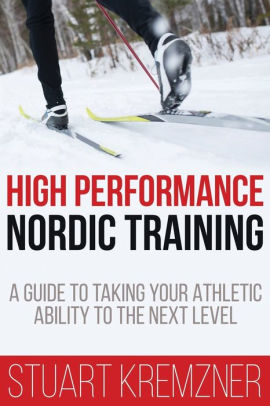 Stuart Kremzner has published a new book with a bold title — High Performance Nordic Training: A Guide to Taking Your Athletic Ability to the Next Level. Kremzner is an exercise physiologist and nordic coach and also the author of the Bill Koch League leader manual, last updated in 2008.
Stuart Kremzner has published a new book with a bold title — High Performance Nordic Training: A Guide to Taking Your Athletic Ability to the Next Level. Kremzner is an exercise physiologist and nordic coach and also the author of the Bill Koch League leader manual, last updated in 2008.
Training, even restricted to a single sport, is a complex topic with unending opportunities to dive into bewildering detail and unexplored research topics. Anyone who has spent time in sport will know there is a long history of bad ideas, pseudo-science, and anecdotal ‘proof’ cluttering up the emerging evidence for best practices. There are many competing books of varying age, quality, and length.
“I hope this general framework will give the reader the basic tools to guide their training development decisions.” — From the Introduction
In essence, this short book is an introduction to developing and improving a cross-country ski training plan.
One way Kremzner reduced the size and complexity of the book was to filter out all the references and scientific evidence behind the ideas. While this choice greatly improves readability, it leaves the reader with a decision about whether to trust the author. That said, readers without a reasonable background in biochemistry and physics need to trust the author, as research journals are written for academics. As a long time nordic nerd and someone who reads sports physiology journals in his free time, Kremzner passes my test.
The author’s references to training theory are at a high level. If you are interested in how to achieve goals with interval workouts, for example, the fundamentals are fleshed out. If you want the thermodynamic detail of why the ATP cycle is directional, you need to look elsewhere. If you don’t understand how the previous two sentences are connected, this book is a good place to start.
This book has two weaknesses: One of those weaknesses is also the book’s biggest strength.
The book is short, focusing on a high level view of endurance training’s building blocks and how to organize them. Yes, the book will leave you wanting more, but it provides a solid road map to recognizing what is next on your learning journey. In a world where it is so easy to get lost in details and forget the goal, this book is a handy reminder of how to find your way out of the swamp and onto the freeway towards the destination.
The second weakness is one that most of us who have been in the sport multiple decades share. After long experience, it is easy to think that ‘good enough for now’ will always be ‘acceptable’. Very few of us escape blind spots based on ‘we always did it that way and there was never a problem’. While Kremzner is correct in suggesting that roller skiing is a very good way to do lactate testing, this is no longer acceptable as a justification to publish a picture of an athlete roller skiing without a helmet.
The author set a bold goal with the title. Whether you should take him at his word and buy this book depends on where you are on your personal training and coaching journey.
If you are self-coached and new to training theory, this is a clear and simple introduction – this is a recommended read.
If you are self-coached and have known the basics for a decade or more, this is a quick way to check yourself for blind spots. Recommended.
If you are coaching, this will help you design plans for your athletes. The book includes simplified explanations of the ‘whys’ that may help you communicate the theory in your mind, and in turn, allow your athletes to better understand how their training applies to race day speed. That’s a win-win. Recommended.
If you are coaching athletes on the World Cup red group, and this is a small niche, you already know more than this book covers. Not recommended.
“This is in no way a substitute for a well-qualified coach.” — From the Introduction
At the end of the ski day, we can spend hours in the bar arguing tiny details and incremental gains. None of that matters if we don’t get the big things right. This book is a quick read about the big things.
(Note to readers: Kremzner has been a contributor to FasterSkier.)



